Keywords
|
| Renewable energy interface unit, Point of Common Coupling (PCC), Power quality improvement |
INTRODUCTION
|
| More versatile methods of power generation are being implemented world-wide for safe, reliable and quality electricity supply. The concepts to achieve the above goals are use of renewable energy sources and use of a custom power device such as STATCOM (Static Synchronous Compensator) as interface unit. When a renewable energy source is used with a power electronic interface, we need other power converters for power conditioning which make the system bulky. In this paper STATCOM is used as an interfacing unit between renewable energy source and grid. In addition to this STATCOM unit provides reactive power compensation, voltage regulation, power factor correction and also control of real power flow from the source (grid) and renewable energy. |
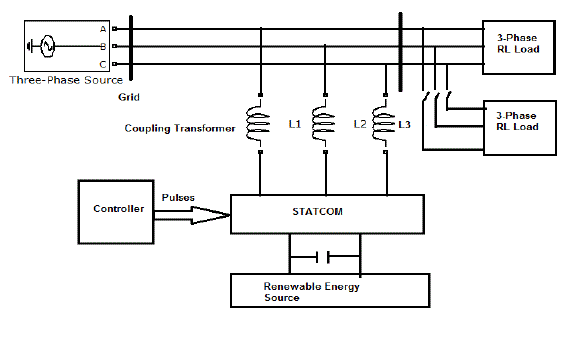 |
| Fig. 1 Schematic of the three phase grid system with the STATCOM Interface for renewable energy source |
| The STATCOM unit is an inverter with DC link capacitor which gets its control pulses from a controller circuit. The STATCOM is a power electronic device which inject or absorb reactive current. The main advantage of the STATCOM is that the compensating current does not depend on the voltage level of the Point of Common Coupling. This paper also compares the performance of proposed instantaneous reactive power theory algorithm with the synchronous reference frame algorithm for STATCOM control. |
CONTROL ALGORITHMS
|
| A. Instantaneous Reactive Power Theory (IRPT) |
| This theory [3] is based on the transformation of three-phase quantities to two-phase quantities and the calculation of instantaneous active and reactive power in this frame. ea, eb and ec, iLa, iLb and iLc are fed to the controller, and these quantities are processed to generate reference currents. The switching signals for the STATCOM is generated by comparing source current and reference current. The block diagram of the IRPT control algorithm is shown in Fig.2. |
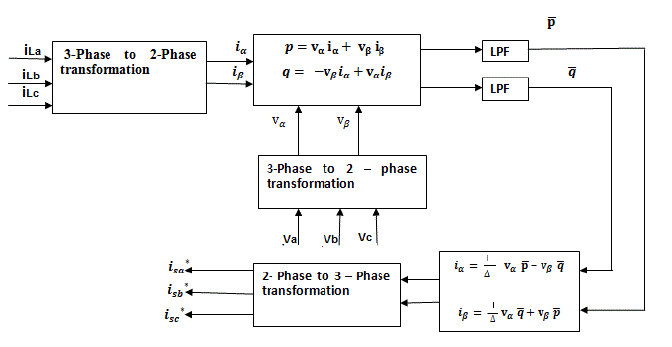 |
| Fig.2 Block diagram of IRPT control algorithm |
| The three phase voltages and currents are transformed in to two phase voltages and currents as follows |
 |
 |
| eα, &iα and &ebeta;,iβ are the voltage and current along α − β axis |
| The conventional instantaneous active power on the three phase circuit can be defined as follows |
 |
| Where p is equal to the conventional equation: |
 |
| The conventional instantaneous reactive power on the three phase circuit can be defined as follows; |
 |
| Instantaneous active and reactive power in matrix is |
 |
| The α − β currents can be obtained as |
 |
Where  |
| The instantaneous active and reactive powers p and q can be decomposed into an average and an oscillatory component |
 |
 |
| where p and q are the average (dc) part and p and q are the oscillatory(ac) part of these real and reactive instantaneous powers. The dc component of active and reactive power is taken to calculate the reference current. |
| The reference currents in α − β co ordinate are expressed as |
 |
| The reference current in three phase is, |
 |
| B. Synchronous Reference Frame (SRF) theory |
| The conventional SRF method [6] can be used to extract the harmonics contained in the supply voltages or currents. For current harmonic compensation, the distorted currents are first transferred into two-phase stationary coordinates using α − β transformation (same as in p-q theory). After that, the stationary frame quantities are transferred into synchronous rotating frames using cosine and sines functions from the Phase-Locked Loop (PLL). The sine and cosine functions help to maintain the synchronization with supply voltage and current. The conventional SRF algorithm is also known as d-q method, and it is based on a−b−c to d−q−0 transformation (park transformation). Here the Proportional Integral (PI) controller is used to eliminate the steady state error of the DC-component of the inverter and maintains the dc-side capacitor voltage constant. The dc capacitor voltage is sensed and compared with reference voltage to calculate the error voltage. In accordance to the PI controller, output is subtracted from the direct axis (d axis) of harmonic component for eliminating the steady state error. |
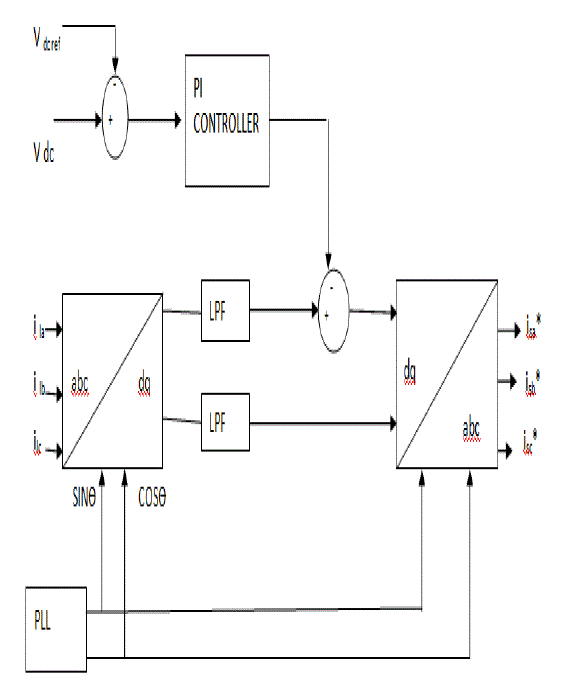 |
| Fig.3 Synchronous Reference Frame Controller |
SIMULINK MODEL AND RESULTS
|
| The simulation of the three phase grid system supplying two linear RL-load and STATCOM interface for renewable energy source has been done using MATLAB /Simulink. For the simulation purpose the renewable energy source output is considered as a rectified DC voltage source connected to DC link of STATCOM. The control pulses for the STATCOM are generated using instantaneous reactive power theory algorithm and synchronous reference frame algorithm. |
| A. Without STATCOM Compensator |
| The power system consists of a three phase source of 400V, 50Hz which supplies real and reactive power to a combination of two numbers of RL linear loads switched at different time interval behaves as a dynamic load for the system. In this condition, source (grid) is responsible for handling the total real power and reactive power demands of the load. The simulink model of the three phase grid system without compensator is shown in Fig.4. The corresponding source voltage and current are shown in Fig5. and Fig.6. From Fig.6 one can easily understand the second load is switched on after the time t= 0.07sec and current magnitude changed to higher level. This current is lagging the source voltage by some angle based on reactive power requirement of linear dynamic loads. Because of this current rise a voltage sag produced in the source (grid voltage). The real and reactive power supplied by the source is of 2.816kW and .023kVar. |
 |
| Fig.4 Simlink model of three phase grid system without compeanator |
 |
| B. Instantaneous reactive power theory |
| The simulink model of the STATCOM for renewable energy source with instantaneous reactive power theory control is shown in Fig.9 and simulink model of the control algorithm shown in Fig.10. Fig.12 and Fig.13 are the voltage and current wave forms of the three phase system, taken at the source(grid)side and Fig.14, Fig.15 are voltage and current wave forms measured at load side of the system. From Fig.13 and Fig.15 one can easily understand the second load is switched on after the time t= 0.07sec and current magnitude changed to higher level, but the voltage sag will not occur due to the presence of STATCOM. It provide input power factor of 0.8815 and source current THD 5.658%. |
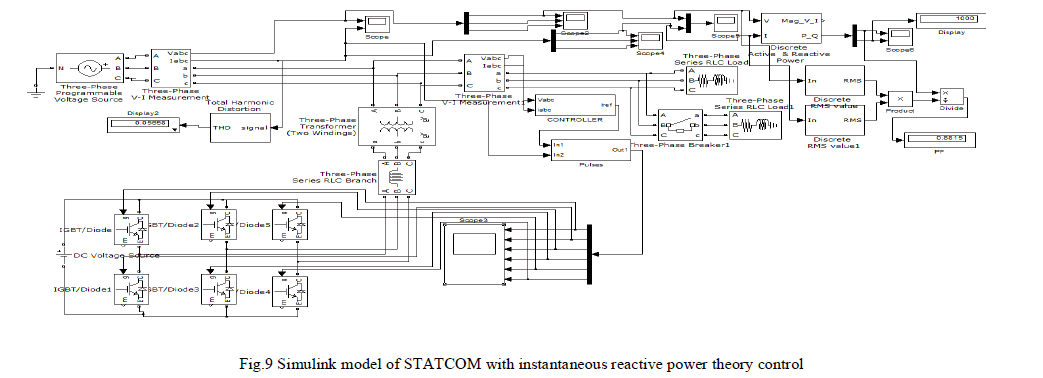 |
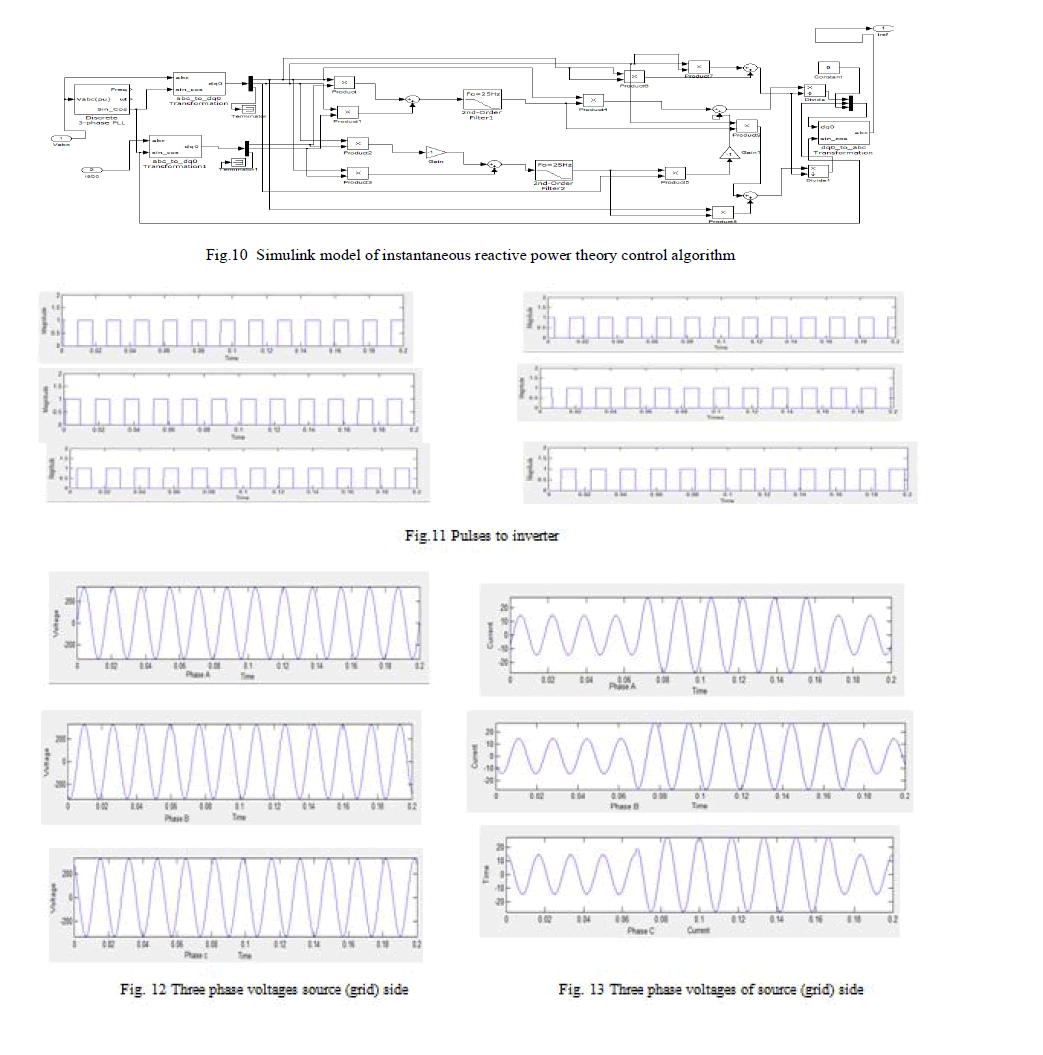 |
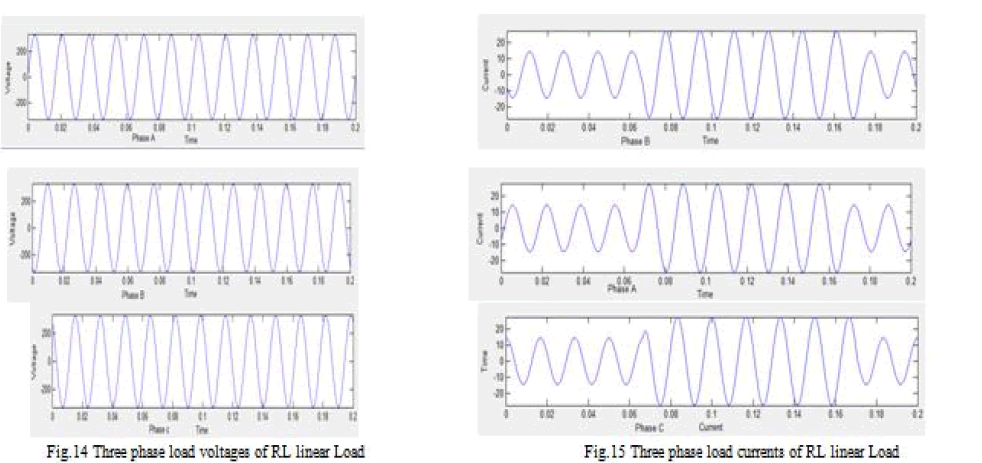 |
| The active and reactive power of STATCOM unit at PCC is shown in Fig.16. For less than .07sec the STATCOM unit supply real power of and reactive power of 900w and 500Var respectively. After .07sec load switched on, providing real and reactive power of 1867w and 1000Var respectively. |
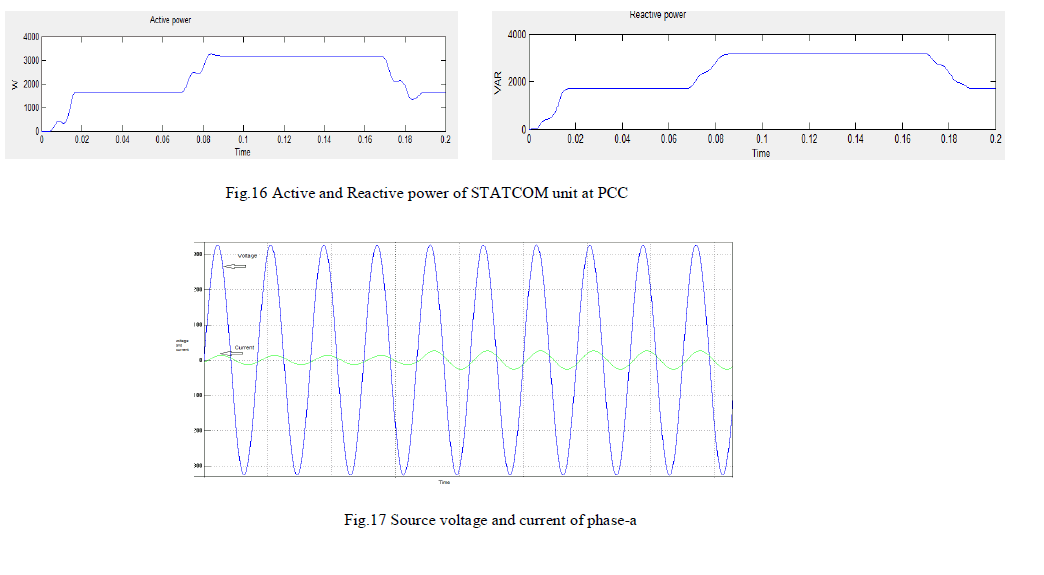 |
| C. Synchronous Reference Frame (SRF) theory |
| The simulink model of the STATCOM for renewable energy source with SRF theory control is shown in Fig.18 and simulink model of the SRF control algorithm is shown in Fig.19. Fig.21 and Fig.22 shows the source voltage and source current. |
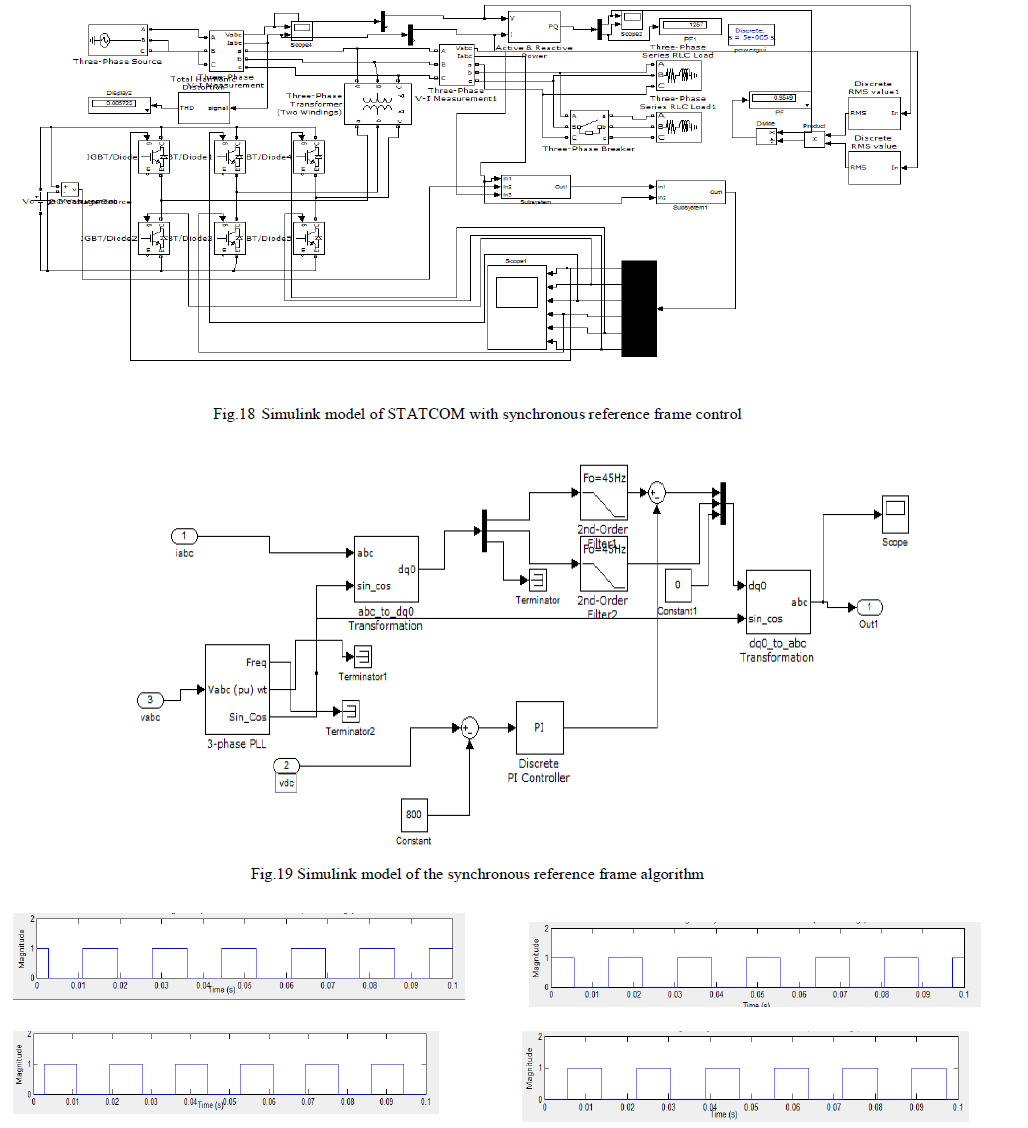 |
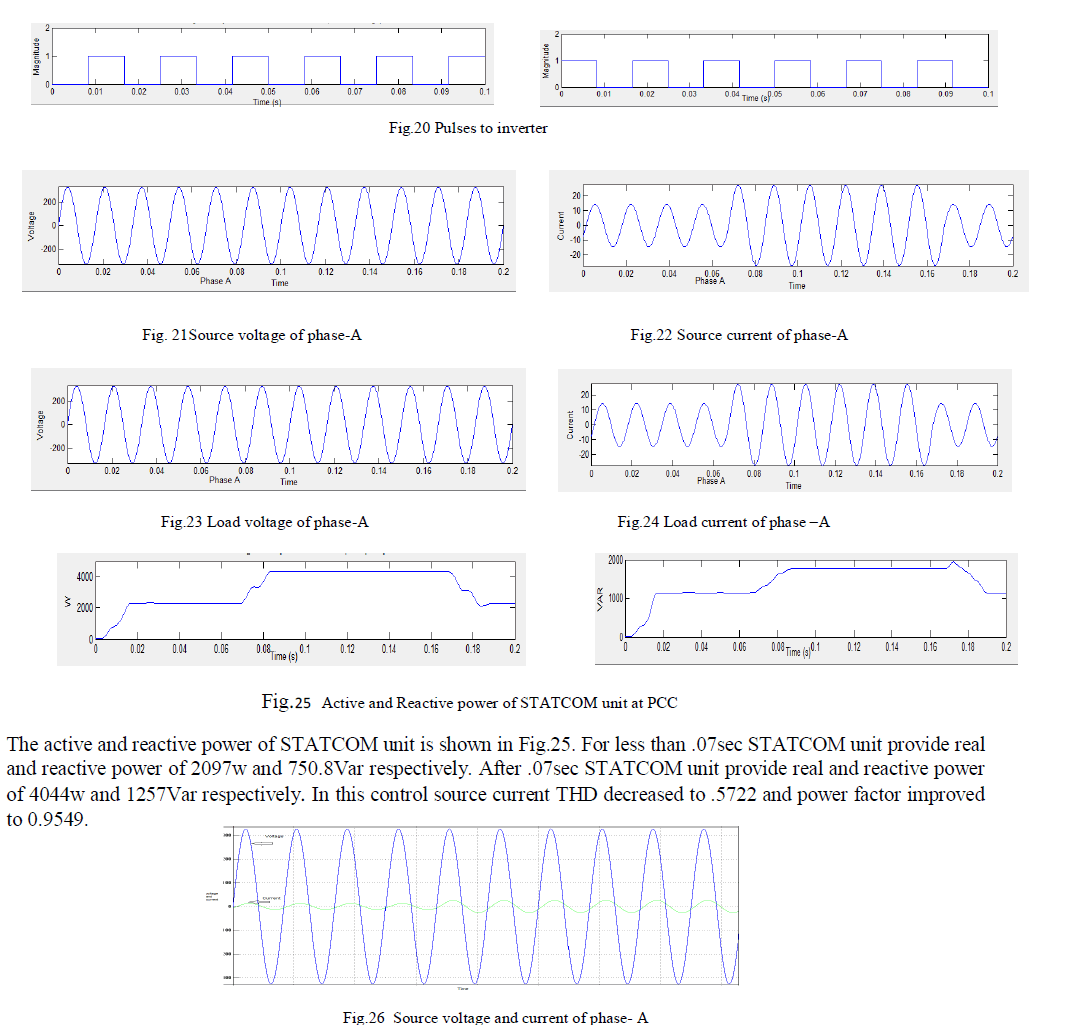 |
| Fig.26 shows the phase-A grid voltage and current after compensation. This waveform makes clear that grid voltage and current are in phase and thereby the power factor is virtually equal to unity. Hence it is proven that the power factor of the three phase system is improved using the SRF controller. |
| D. Comparison of control algorithms |
| A comparison between IRPT and SRF control algorithm for generating control pulses for the STATCOM are done based on their performance parameters. STATCOM unit with SRF control pulses provide better source current and voltage THD with better power factor. |
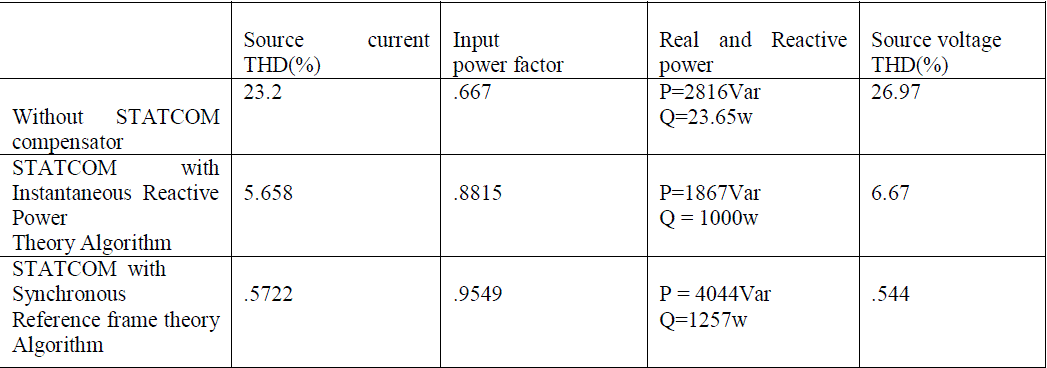 |
CONCLUSION
|
| In this paper a STATCOM unit is developed for interfacing renewable energy source to the grid with improved power quality. Instantaneous reactive power theory and synchronous reference frame algorithm was developed for generating control pulses for the STATCOM unit. This STATCOM unit provide power factor correction, real and reactive power compensation and voltage regulation. A comparative study has been done for the two control algorithms to achieve the above objectives. From comparative study it is clear that synchronous reference frame algorithm is better in performance compared to instantaneous reactive power theory control algorithm. The STATCOM unit with SRF algorithm provide better performance with input power factor of 0.9549 and source voltage and current THD of 0.5722, 0.544 respectively. |
References
|
- Ilango K, Bhargav.A, Trivikram.A, Kavya.P.S, Mounika.G, and Manjula G. Nair “ Power Quality Improvement using STATCOM withRenewable Energy Sources” 978-1-4673-0934-9/12 IEEE2012
- J. G. Pinto, R. Pregitzer, Luis F. C. Monteiro, Joao L. Afonso, “3-Phase 4-Wire Shunt Active Power Filter with Renewable Energy Interface”.
- H. Akagi, Y. Kanazawa and A. Nabae, “Instantaneous Reactive Power Compensators comprising Switching Devices without Energy StorageComponent”, IEEE Transac. On Industry Applications,1984.
- H. L. Jou, “Performance Comparison of the three – phase active – power – filter algorithms”, IEE Proc. Vol. 142. No. 6, November 1995.
- G. Bhuvaneswari, Manjula G. Nair, “Design, Simulation and Analog Circuit Implementation of a Three – Phase Shunt Active Filter Using theIcosΦ Algorithm”, IEEE Transactions on Power Delivery April 2008.
- Marta Molinas, Jon Are Suu and Tore Undeland “Improved grid interface of induction generators for renewable energy by use ofSTATCOM” IEEE 1-4244-0632-3/07, 2007.
- Joseph A. Carr, Juan Carlos Balda, H. Alan Mantooth, “A Survey of Systems to Integrate Distributed Energy Recourses and Energy Storage onthe Utility Grid”, IEEE Energy 2030 Atlanta, Georgia, USA, 17-18 November 2008
|